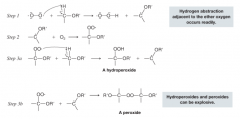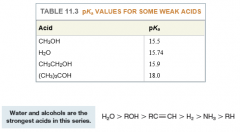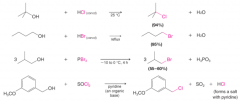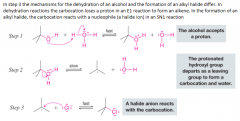![]()
![]()
![]()
Use LEFT and RIGHT arrow keys to navigate between flashcards;
Use UP and DOWN arrow keys to flip the card;
H to show hint;
A reads text to speech;
12 Cards in this Set
- Front
- Back
|
Phenols
|

- Compounds that have a hydroxyl group attached directly to a benzene ring
|
|
|
Nomenclature of Ethers
|

- ethers are named as alkoxyalkanes, alkoxyalkenes, and alkoxyarenes. The RO─ group is an alkoxy group
|
|
|
Cyclic Ether Nomenclature
|

- One simple way is to use replacement nomenclature, in which we relate the cyclic ether to the corresponding hydrocarbon ring system and use the prefix oxa- to indicate that an oxygen atom replaces a CH2 group - In another system, a cyclic three-membered ether is named oxirane and a four-membered ether is called oxetane. |
|
|
Ether Boiling Points
|
- Ethers have boiling points that are roughly comparable with those of hydrocarbons of the same molecular weight (MW).
|
|
|
Alcohol Boiling Points
|
- Alcohol molecules can associate with each other through hydrogen bonding, whereas those of ethers and hydrocarbons cannot |
|
|
Autoxidation of Diethyl Ether
|

Most ethers react slowly with oxygen by a radical process called autoxidation (see Section 10.12D) to form hydroperoxides and peroxides:
|
|
|
Alcohols as Acids
|

- All alcohols are much stronger acids than terminal alkynes, and they are very much stronger acids than hydrogen, ammonia, and alkanes - Conjugate bases of compounds with higher pKa values than an alcohol will deprotonate an alcohol. |
|
|
Relative Basicity
|

|
|
|
Conversion of Alcohols into Alkyl Halides
|

- All of these reactions result in cleavage of the C─O bond of the alcohol. - each case, the hydroxyl group is first converted to a suitable leaving group. - The most commonly used reagents for conversion of alcohols to alkyl halides are the following: • Hydrogen halides (HCl, HBr, Hl)• Phosphorus tribromide (PBr3)• Thionyl chloride (SOCl2) |
|
|
Formation of Alkyl Halides from Alcohols
|

- The order of reactivity of alcohols is 3°>2°>1° - The order of reactivity of the hydrogen halides is HI>HBr>HCl (HF is generally unreactive). - Primary and secondary alcohols can be converted to alkyl chlorides and bromides by allowing them to react with a mixture of a sodium halide and sulfuric acid |
|
|
Mechanism of Reaction of Alcohol with HX
|

- The first two steps in this SN1 substitution mechanism are the same as in the mechanism for the dehydration of an alcohol - In step 3 themechanisms for the dehydration of an alcohol and the formation of an alkylhalide differ. In dehydration reactions the carbocation loses a proton in an E1reaction to form an alkene. In the formation of an alkyl halide, thecarbocation reacts with a nucleophile (a halide ion) in an SN1 reaction - Secondary, tertiary, allylic, and benzylic alcohols appear to react by an SN1 mechanism
|
|
|
Mechanism of Conversion of an Alcohol into a Mesylate (an Alkyl Methanesulfonate)
|

|

